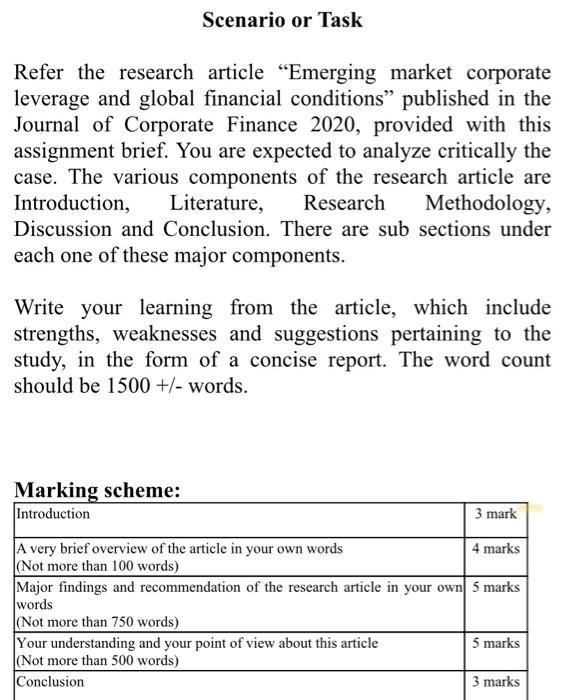Scenario or Task Refer the research article "Emerging market corporate leverage and global financial conditions published in the Journal of Corporate Finance 2020, provided with this assignment brief. You are expected to analyze critically the case. The various components of the research article are Introduction, Literature, Research Methodology, Discussion and Conclusion. There are sub sections under each one of these major components. Write your learning from the article, which include strengths, weaknesses and suggestions pertaining to the study, in the form of a concise report. The word count should be 1500 +/- words. Marking scheme: Introduction 3 mark A very brief overview of the article in your own words 4 marks (Not more than 100 words) Major findings and recommendation of the research article in your own 5 marks words (Not more than 750 words) Your understanding and your point of view about this article 5 marks (Not more than 500 words) Conclusion 3 marks 2 I. INTRODUCTION Corporate leverage in emerging markets (EMS) has risen sharply over the past decade amid favorable global financial conditions. The corporate debt of nonfinancial EM firms has increased fivefold from about USS5 trillion in 2006 to more than US$25 trillion in 2018 (Figure 1). Likewise, the EM nonfinancial corporate-debt-to-GDP ratio has risen by more than 50 percentage points over the same period, reaching a peak of over 100 percent. Most of the recent literature has emphasized the surge in EM corporate bond issuance. However, only large firms typically have access to capital markets, as emphasized in studies including Gertler and Gilchrist (1993) and Beck and others (2006). Whereas large firms make greater use of capital markets (including for bond issuance), small- and medium-sized enterprises (SMEs) are more restricted in their external financing options and rely heavily on loans-in particular, credit intermediated through banks, as noted in Gertler and Gilchrist (1994) and Kersten and others (2017). "Focusing exclusively on how EM corporate bond issuance is related to global financial conditions therefore runs the risk of overlooking the important role of a large segment of the corporate sector, including financially constrained firms such as SMEs. By contrast to the United States, the bulk of real economic activity in EMs may not be fully accounted for by large firms (Kalemli-Ozcan and others, 2015). In particular, SMEs account for a vast majority of firms, employment, and value added across countries' corporate landscapes (de la Torre, Martinez Peria, and Schmukler, 2008). At the same time, bank loans remain the main source of financing for the EM corporate sector, and, more generally, most financial systems are still predominantly bank-based (Brauning and Ivashina, 2019; Cihak and others, 2012; IMF, 2015). Taken together, SMEs and other (non-listed) firmswhich have limited access to the capital markets and thereby are more dependent on bank-based financing--are likely to be key drivers of EM corporate leverage dynamics. Therefore, studies that focus solely








